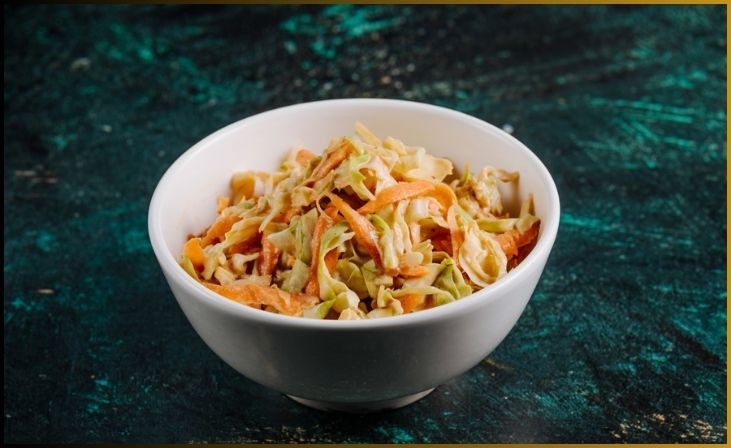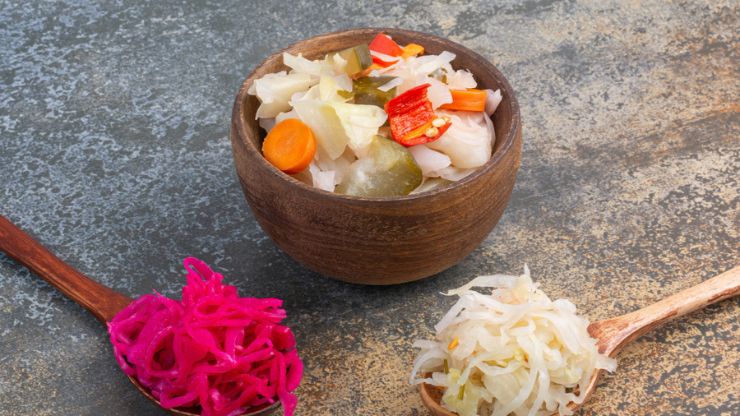I stumbled across this sauerkraut recipe as I felt adventurous to add some new flavors to the fermenting that occurs in my home. I have a husband, children, and sister who are all partial to Asian-flare tastes, so I gave this Miso Ginger Sauerkraut a go! It was quite the hit! Even for the youngest enjoyed!
Unlock the extraordinary fusion of flavors with our Miso Ginger Sauerkraut recipe. This innovative take on the classic sauerkraut introduces the umami-rich essence of miso and the zesty kick of ginger, elevating your probiotic delight to new heights. Sauerkraut lovers, get ready to embark on a journey of taste and health!
Sauerkraut, with its historical roots in Eastern Europe, meets the East in this inspired recipe. The natural fermentation process, combined with the goodness of miso and ginger, creates a harmonious blend of flavors that will tantalize your taste buds. We’ll guide you through the steps to infuse your sauerkraut with these delectable ingredients, adding a unique twist to a time-honored tradition.
In this blog post, you’ll find the perfect balance between tradition and innovation. Get ready to savor every spoonful of this Miso Ginger Sauerkraut, packed with probiotics and a rich, savory taste. Let’s explore the culinary artistry of fermenting cabbage, miso, and ginger.
Table of Contents
ToggleMiso Ginger Sauerkraut Recipe

In recent years, fermented foods have gained popularity due to their numerous health benefits, and Miso Ginger Sauerkraut is no exception. This flavorful and probiotic-rich condiment can be a delightful addition to your diet. In this article, we’ll guide you through the process of making Miso Ginger Sauerkraut at home.
The Ingredients:
To embark on this culinary adventure, gather the following ingredients:
- 2 Tablespoons Miso Paste
- 1/4 Cup boiling filtered water
- 1 Medium Cabbage thinly sliced
- 3 Tablespoons Fermentools’ Himalayan Salt
- 1 1/2 cup Shredded carrots
- 2 bunches chopped green onion
- 3/4 – 1 cup shredded ginger root
Equipment You need
You will need the following kitchen tools:
- A large mixing bowl
- A sharp knife or a mandolin
- A fermentation vessel (glass jar or crock)
- A weight (to keep the sauerkraut submerged)
- A clean cloth or paper towel
The Method:
(1) Shred your cabbage into thin slices and place it into a large bowl. Sprinkle the salt on the cabbage and use your hands to squeeze and smash the cabbage until it is soft and releases its natural juices creating a brine for your sauerkraut.
(2) Dissolve your miso in boiling water and set it aside to cool.
Don't just scroll, subscribe!
BuzzTrail's unique web-stories are the cure for boredom you've been waiting for.
(3) Add the carrots, green onions, and ginger to the bowl and combine well. When cool, mix the miso mix in the bowl as well covering all the vegetables.
(4) Pack your sauerkraut into a half-gallon mason jar little by little packing it down as tightly as possible leaving 1-2 inches of head space at the top of the jar. Place your Fermentools’ glass weight inside the jar pressing the cabbage beneath the brine. Install your Fermentool’s airlock system and set your ferment aside to ferment away!
Taste your Miso Ginger Kraut every few days because, well, it’s delicious, and so you can move it to cold storage when it is sour enough for your taste preferences.
Do not be caught off guard! No stir fry to sticky rice should ever be left without this ferment to accompany it. Another Asian-flare sauerkraut to try would be the pad thai sauerkraut.
Fermentation Process
- Once you’ve prepared the sauerkraut mixture, carefully transfer it into your designated fermentation vessel. Make sure to pack it down firmly to eliminate any trapped air bubbles.
- To ensure that the sauerkraut remains submerged in its natural juices during fermentation, place a weight on top of the mixture. This step is crucial to the overall quality of your sauerkraut.
- Cover the vessel with a clean cloth, securing it in place with a reliable rubber band. This covering protects the sauerkraut from contaminants while allowing gases to escape during the fermentation process.
- Find a suitable location in your home – ideally a cool, dark spot – to store the vessel. The sauerkraut will undergo fermentation for a period ranging from 7 to 14 days, depending on your desired level of tanginess.
- Regularly check on the sauerkraut during this time to ensure that the liquid maintains its coverage over the sauerkraut. This is a critical step to prevent spoilage and ensure a successful fermentation process.
By following these steps diligently, you’ll be on your way to producing delicious, homemade sauerkraut with the perfect balance of flavors and textures.
Quick Link: Sauerkraut, not Sourcrout!
Health Benefits of Miso Ginger Sauerkraut

- Miso Ginger Sauerkraut isn’t just a flavorful addition to your meals; it’s a nutritional powerhouse with a multitude of health benefits.
- Abundant in probiotics, this sauerkraut variety plays a vital role in nurturing a healthy gut environment, thus enhancing digestion and overall well-being.
- Beyond its digestive advantages, this sauerkraut offers a generous supply of essential nutrients. These include vitamins, minerals, and antioxidants that contribute to your daily dietary requirements.
- A strong immune system is crucial for warding off illnesses and infections. The sauerkraut’s combination of ingredients, including miso and ginger, supports your body’s immune function, helping you stay resilient against various health challenges.
- The probiotics present in Miso Ginger Sauerkraut are well-documented for their capacity to improve nutrient absorption and overall gut health.
- As part of a balanced diet, incorporating this sauerkraut into your meals can aid in maintaining a stable and diverse gut microbiome, which is essential for overall health.
- With its unique blend of flavors and numerous health benefits, Miso Ginger Sauerkraut is a delicious way to prioritize your well-being while enjoying the journey to better health.
Amazing Recipe Tips
- Maintaining Cleanliness: Before starting the sauerkraut-making process, it’s essential to ensure that all your equipment, including jars, bowls, and utensils, is thoroughly cleaned and free from any lingering residue. This precaution helps prevent the growth of unwanted bacteria and ensures the success of your fermentation.
- The Flavors of Fermentation: As the sauerkraut ferments, its flavor profile undergoes subtle changes. To tailor the taste to your preferences, make it a habit to sample your sauerkraut during the fermentation period. This practice allows you to gauge its flavor and readiness, ensuring that it reaches the desired level of tanginess.
- Taste Testing: Don’t be afraid to take a small sample from your fermenting sauerkraut. Regular tasting helps you monitor the transformation of flavors, so you can stop the fermentation process at the exact point that suits your taste buds.
- Adjusting Fermentation Time: The length of fermentation varies based on personal preference. Some enjoy a milder flavor and prefer a shorter fermentation period, while others like a stronger, tangier taste and opt for a longer duration. Taste-testing allows you to fine-tune the final product to your liking.
- Avoiding Contamination: When tasting your sauerkraut, ensure that the utensils used are clean and have not been in contact with other food items to prevent contamination.
- Experimenting with Flavors: While you’re at it, consider experimenting with different seasonings and spices during the fermentation process to create unique flavor variations that suit your palate.
- Enjoy the Journey: Making sauerkraut is not only about the final product; it’s also a journey of exploration and taste. Embrace the opportunity to customize your sauerkraut to perfection with these helpful tips.
Final Words
The Miso Ginger Sauerkraut recipe is a delightful fusion of East meets West in the world of fermented foods. By infusing the traditional sauerkraut with the bold flavors of miso and ginger, you’ll embark on a culinary journey that marries the old and the new, the familiar and the innovative. The probiotic-rich goodness of sauerkraut is enhanced by the complexity of umami from miso and the zesty warmth of ginger.
As you venture into the world of Miso Ginger Sauerkraut, remember that experimentation is encouraged. You can tailor the recipe to your taste preferences and explore the unique variations that miso and ginger can offer. Enjoy the flavors, the health benefits, and the satisfaction of creating a modern twist on a classic favorite. Get ready to elevate your sauerkraut experience with this exceptional Miso Ginger Sauerkraut recipe.
FAQs (Frequently Asked Questions)
1. What is miso, and why is it used in sauerkraut?
1. What is miso, and why is it used in sauerkraut?
Miso is a traditional Japanese seasoning made by fermenting soybeans, salt, and sometimes grains. It adds an umami flavor to sauerkraut and enhances its depth of taste.
2. How does ginger enhance the sauerkraut’s flavor?
2. How does ginger enhance the sauerkraut’s flavor?
Ginger’s spicy and aromatic notes complement the tanginess of sauerkraut, creating a balanced and zesty profile that’s a delight to the palate.
3. Can I use different types of miso in this recipe?
3. Can I use different types of miso in this recipe?
Certainly! You can experiment with various miso varieties, such as white miso, red miso, or brown miso, to achieve different flavor profiles in your sauerkraut.
4. How long does this Miso Ginger Sauerkraut need to ferment?
4. How long does this Miso Ginger Sauerkraut need to ferment?
Fermentation time can vary depending on your preferences. Generally, it’s best to let it ferment for at least one to two weeks to develop the desired texture and tanginess.

